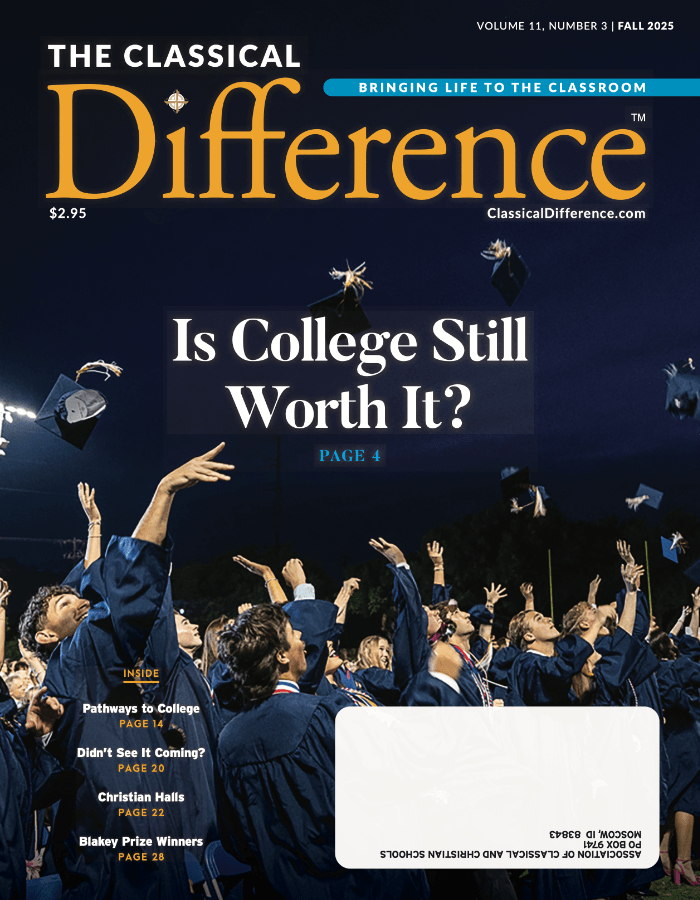Spring 2018
This issue focused on Learning Disabilities and the classical model.
More from Laura Tucker:
Other Articles
My Child has Learning Disabilities: Can a Classical Christian School Work for Us?
Difficulty vs. Disability: Embracing the Struggle with Learning Disabilities
Tools for Parents: Learning Disabilities
“Mercy” Meets the “Law” in Learning Disabilities

How the Classical Method Helps at Various Stages
Grammar students with mild to moderate learning disabilities benefit from the classical methodology of systematic and repetitive instruction. In CCE schools reading instruction begins with the systematic instruction of phonics, and when this instruction includes an Orton-Gillingham based methodology as it often does, younger students with reading disabilities tend to succeed in gaining the tools necessary to read, spell, and write. Schools for children with dyslexia apply this same methodology in their instruction.
In addition, children with written language disabilities benefit from the early systematic instruction of phonics that requires them to spell and write what they are learning to read. The consistent reinforcement of this methodology is an important foundation for building these skills. As the student advances through the grammar years and since most teaching during the CCE school day requires writing, the provision of extended time may give the student the opportunity to show what he knows especially if there is a fine motor weakness or a limitation in speed and accuracy.
Some schools have decided to allow older students with dyslexia to replace Latin with a study hall to complete tests or unfinished assignments, yet the question remains in the minds of other schools: Can a classical school still be classical if some students do not take Latin?
For older students with mild mathematical disabilities, the use of calculators in the classroom increases productivity. For students with processing speed weaknesses in reading, written language, or math, the accommodation of extended time on assignments and tests can result in the demonstration of their knowledge.
Not only are accommodations beneficial in the K-12 classrooms, but as students near graduation, schools can apply for accommodations for students with learning disabilities through the College Board which can result in extended time on standardized exams or the use of a scribe.
Many students with mild to moderate learning disabilities can succeed in a CCE school because the CCE methodology equips them with a foundation to learn. These schools stand in the place of parents and teach the Word of God and its principles; therefore, students are taught to work hard. Teachers in CCE schools are trained to teach using visual, auditory, and kinesthetics modalities which is excellent instruction for all students but especially for those with learning differences.
Even though the CCE methodology, curricula, and instruction establish the groundwork for learning, it is essential that a strong partnership between the school and home exists. The younger student needs much support from parents who communicate closely with the school and who reinforce concepts that are difficult for the student. Both the younger and older students need much encouragement because learning for them is especially challenging, and the pace of instruction often requires additional time at home to work on assignments.
Signs and Symptoms of Learning Disabilities
Dyslexia is a type of reading disorder. In Greek, it means difficulty with language. A student with dyslexia has difficulty reading, writing, and spelling. Reading comprehension, decoding, reading fluency, and recall are affected.
Signs and symptoms: https://ldaamerica.org/types-of-learning-disabilities/dyslexia/
Dyscalculia is a type of math disorder. A student with dyscalculia has difficulty recalling and organizing numbers and symbols.
Signs and symptoms: https://ldaamerica.org/types-of-learning-disabilities/dyscalculia/
Dysgraphia is a type of writing disorder. In Greek, it means difficulty with writing. A student with dysgraphia has an impairment in handwriting which can affect speed of writing and spelling even if there is no reading disorder. Additional information: https://dyslexiaida.org/understanding-dysgraphia/
Not all students with reading, writing, or math specific learning disabilities have dyslexia, dysgraphia, or dyscalculia. A student may have a writing disability specifically in written expression. A student may have a reading disability specifically in comprehension.
In addition, students with specific learning disabilities may have concomitant disorders in Executive Function (difficulty planning, organizing, and completing tasks), listening comprehension, social skills, language, memory, etc.
Sample IQ Score Sheet and Analysis
The following is an explanation of the Cognitive/Intellectual Testing and how specific learning disabilities are diagnosed. Use this reference to understand standard scores and to identify functioning levels (Very Superior-Deficient). This will clarify 100 as 50th percentile= Average
This is an example of a student’s Index scores on the WISC-V (a commonly used cognitive test). The index scores are summaries of individual subtest scores.

To determine if a student has a learning disability, the standard scores are compared. There is at least one of more standard deviations (+-/15) between this student’s Working Memory Index score (132) and her other index scores. She is a bright student (Working Memory is Very Superior), but when her strong ability is compared to the other index scores particularly her (Processing Speed) there is a discrepancy.
Even though most of this student’s functioning levels are at the Above Average-Average ranges, the student is diagnosed with a learning disability. The Full Scale Score is meaningless. This student does not have an average ability.
Even though the Full Scale IQ score is used to identify a child’s intelligence, it is not an accurate assessment of his intellectual ability. The IQ score is comprised of separate index scores. It is important to compare these scores. When there is a standard deviation of +-/15 between any of the index scores (standard scores), then a potential cause of the student’s learning struggle can be identified and determined to be a specific learning disability.
Detailed Definitions and Resources
Cognitive development: “Cognitive Development” means [fill in] . On a standard IQ test, a below average measurement is [fill in]. The different [learning areas/categories] are [list areas here]. A 100 score is average. Below average functioning in most areas is considered an intellectual disability.
Cognitive Development – https://www.cde.ca.gov/sp/cd/re/itf09cogdev.asp The term cognitive development refers to the process of growth and change in intellectual/mental abilities such as thinking, reasoning and understanding. It includes the acquisition and consolidation of knowledge.
CC educators teach according to the stages of cognitive development: Poll-Parrot, Pert, Poetic corresponding with the Trivium.
Intellectual disability is a disability characterized by significant limitations in both intellectual functioning and in adaptive behavior, which covers many everyday social and practical skills. This disability originates before the age of 18.
Intellectual functioning—also called intelligence—refers to general mental capacity, such as learning, reasoning, problem solving, and so on. One way to measure intellectual functioning is an IQ test. Generally, an IQ test score of around 70 or as high as 75 indicates a limitation in intellectual functioning.
Intellectual Functioning or Ability – http://aaidd.org/intellectual-disability/definition#.Wnuos-jwZnI
Real Life Stories
I will highlight three students who graduated from a CCE school. Each of the students worked very hard at school and home and had supportive parents.
The first student had a reading disability, specifically dyslexia, and he attended a school for students with learning differences before entering the CCE school in 6th grade. He used the accommodation of extended time on tests, and because he did not take Latin, he had a study hall which he used to complete tests and assignments.
The second student had processing speed, fine motor, and speech and language weaknesses that affected his performance in every subject. He entered the school in 7th grade. His accommodations included the use of a lap top to complete tests and assignments. Teachers sent tests to him at the same time other students were taking hard copies of the test. In addition, both teachers and students ensured the student had enough “wait time” to participate in a discussion, answer a question, or make a comment.
The third student entered the CCE school in kindergarten and had processing speed and working memory weaknesses as well as reading and written language disabilities. Because he spent a lot of time outside of school studying and gained the basic tools of reading, writing, and math through the classical methodology, he did not need accommodations during the grammar years; however, during his secondary years he used a lap top to write papers in class and a “smart” pen that recorded lectures and transcribed his notes to a computer screen.
All three of these students applied for and received the accommodation of extended time on the PSAT and SAT exams from the College Board, and each student performed well. In addition, they used the accommodation of extended time throughout college, graduated with degrees, and are working full time.
Comprehensive list of guidelines and questions for a school visit
Visit the school and the classrooms. Observe the grade below your child, the grade of your child, and the grade above your child. Note the pace of the instruction and requirements of each subject (amount of reading, writing, math).
Picture your child in the classroom and ask: How would he/she respond to the instructions? Would he/she need assistance to follow the instructions? If so, what type of assistance? What literature book is the class reading? Has your child read something similar at that level?
Look at the school’s curriculum guide. You will find a list of goals and objectives for each grade and subject. Evaluate the areas where your child is strong and weak.
Meet with the admission director or administrator of the school. Ask if the school has a learning disabilities philosophy. If they do not have one, ask the school if there are children with learning disabilities in the classrooms and what accommodations they provide. Share the strengths and weakness of your child and what you have learned after observing in the classrooms.
Provide a brief written summary of your child’s psychoeducational report and explain his diagnosis, the recommendations, and what your child knows he needs to be a successful learner.
Provide samples of your child’s current work. Ask the admissions director or administrator for their recommendations and advice about your child applying for admission.
Common accommodations
To determine the kinds of accommodations a school can provide for students with learning differences or disabilities, parents should first ask the school if it has a written philosophy for students with special needs. If the school has a philosophy, many questions about accommodations can be answered.
Even if a written philosophy is not available, most classical Christian schools have discussed in-house and decided which accommodations they are capable of meeting. Faculty experience and size, parental involvement and commitment to work with their child, the age of the student, and severity of the learning disability are important considerations for the school.
Because each child is created uniquely by God with individual abilities, a list of certain learning disabilities that CCE schools accommodate is difficult to establish. The specific needs of each student, the capability of the school to meet the student’s needs, and the commitment of the parents to CCE and to the oversight of their child’s education are factors to be discussed to make the wisest decision for the student and the school.
The most common accommodations available for students in CCE schools are the following:
- Extended time on tests and classroom assignments
- For Logic and Rhetoric students Extended time on standardized exams (PSAT, SAT, ACT)
- Use of a laptop for tests and assignments
- Use of a “smart” pen that both records lecture information in class and transcribes notes to a computer screen
- Utilization of a tablet and application of packages to take notes and record lectures to synchronize with notes
- Preferential seating (close to the board or teacher, in a least distracting or a quiet location)
- Purchase of student texts to allow the student to underline or highlight important concepts and to write notes
- Use of a book mark to help the reader locate each line in the text
- Larger font on assignments
- Allowance of wait time (teacher and class provide additional time to the student to answer an oral question or to comment)
- Use of an audio recording of the student’s literature books for at home use. Use of an electronic spell-checker
- Use of graph paper to assist with proper alignment of math problems Use of manipulatives
- Allowance of oral answers on timed math fact or spelling tests Use of a window card, a large index card with a window cut out large enough to see one or two lines of print.
- Use of graphic organizers (flow charts, webs) to assist with organization of material
Full interview Cheryl Swope
1. How does the CCE model uniquely serve those with learning disabilities? A classical Christian education insists on a firm, incremental, mastered foundation of essential content, knowledge, and skills. This approach to education equips a special-needs student far better than those favoring random activities or entertainment-driven lessons. A classical Christian education resurrects common-sense instruction in essentials such as spelling, reading, penmanship, written expression, arithmetic, moral lessons, Latin, and the Christian faith in ways that form students through the language arts (trivium) and the mathematical arts (quadrivium). Other approaches to special needs often emphasize accommodations and side-step hard work, but a classical Christian education urges students to achieve. We can allow for a different pacing, multi-modal teaching, and even a modified classical curriculum without sacrificing the primary goal of teaching children well. With this understanding, a classical Christian education can serve children with autism, ADHD, or dyslexia with greater temporal and eternal rewards than the local public school ever could. This was evidenced with Helen Keller years ago, and is becoming abundantly clear today.
2. How does the CCE community uniquely serve those with learning disabilities? Sadly, sometimes the classical Christian education community does not serve those with learning disabilities well at all! We still have schools that will enroll 3 of 4 children in a family, but the 4th child with autism, intellectual disability, or learning disabilities is relegated to public school. Often this is due not to neglect, but to fear. However, we see increasingly encouraging exceptions to this. Some classical Christian schools offer an aide or a willing peer to “shadow” a student through his coursework. Others provide resource rooms to help students with organizational skills or difficult classes. In some schools, block scheduling allows older learning disabled students to study math or Latin at lower levels. Special academies within classical schools teach children with special needs. All of these models allow students with disabilitiies to remain in the Christian culture of the school. Such students might participate in Shakespeare plays, choral or instrumental music, or physical education alongside his Christian peers, and they can attend chapel, pray, and learn hymns in the Christian community with their brothers and sisters. We must not hide behind the notion that our schools “cannot accommodate your child.”
By embracing students with learning disabilities, the classical Christian community affirms in a powerful and public way the God-given dignity of each human being (See “The Least Among Us,” Fall 2017 SCL Journal). Homeschoolers show us that with a good classical special-needs curriculum, children with special needs can be taught effectively without great expense, and even without special training. Students with special needs might not progress as far as same-age peers, but because a classical Christian education is rich and advanced, emphasizing truth, goodness, and beauty, even at lower levels the benefits of an exemplary education remain. The new alternative program, the Simply Classical Curriculum, is designed specifically for students with special needs. Voted #1 for Special Learners among homeschoolers (OldSchoolhouse Magazine, 2016), the curriculum demonstrates that we can take the necessary time to truly form students while teaching and equipping them. Above all else, a classical Christian education is a formative education. All children, even those with organic brain differences, benefit from a community willing to enfold them with an exemplary education.
3. What do you think are the best ways a teacher or parent can figure out how to help a struggling student? In the book Simply Classical: A Beautiful Education for Any Child, we provide several chapters on assessment to answer this very question because, as you aptly note in your question, the process can require much “figuring out!” The most complete method remains a formal neuropsychological evaluation. In addition to providing clues to overall intellectual ability, this evaluation will uncover issues related to memory, executive function, possible dyslexia or dysgraphia, dyscalculia, and auditory and visual processing. A formal evaluation can reveal strengths that will help you teach him more efficiently. You might also learn that the child struggles with something such as autism or dyslexia, that was previously attributed to a character flaw. When this happens, compassion can replace accusation, and intervention can replace discouragement.
Formal evaluations can be conducted in many areas to include motor or sensory (physical or occupational), speech or language, vision and hearing. Evaluations can often be accomplished through children’s hospitals or university clinics and may be covered by insurance. If not, some public schools provide good assessments. Regardless of the origins of the evaluations, parents, teachers, headmaster, and any ancillary staff can meet together after reading the full written reports to plan a more effective approach that might involve a combination of tutorial, home, and classroom instruction.
4. Do you have any general principles that you believe can help any struggling students, regardless of this issue? Yes! First, identify the level (webinar #2) at which you are currently attempting to teach the struggling student. Is it his independent level (too easy), his frustration level (too difficult), or his true instructional level (just right)? If you are trying to teach him at the frustration level, a level for which he lacks the prerequisites, he will not be the only one frustrated! This must be addressed immediately. Placement is crucial. For anyone interested, we offer free online readiness assessments before beginning the Simply Classical Curriculum to prevent such struggles.
Second, you will need to provide the two-pronged approach of remediation and accommodation. Remediation strengthens his weaker areas and takes time. Accommodation modifies in ways that allow him to continue learning classical content, perhaps orally, while building those weaker skills. Few struggling students can proceed without the combined approach of remediation and accommodation. Too often, programs attempt one without the other. As you do this, no matter the curriculum, teach from content written at a level the child can master.
5. In what ways have you seen these students benefit the community as a whole? I love this question. Mrs. Cheryl Lowe, founder of Memoria Press, said it best in her review of Simply Classical: A Beautiful Education for Any Child. “A classical education is like climbing a mountain, each child benefiting from whatever vistas he or she attains in that upward journey. Cheryl Swope shows us that the special-needs child needs and benefits from the uplifting vision of A classical education as much if not more than those without learning challenges. Simply Classical gives encouragement and real help for all parents who do not want to settle for second best for their special-needs child. In doing so she has advanced the cause of classical Christianeducation by confounding its critics who claim it is only for the elite.” Every student who thrives with a classical Christian education despite his learning challenges “confounds the critics.” Ours is not an elitist endeavor; ours is a human endeavor.
6. Why did you write Simply Classical: A Beautiful Education for Any Child? I wrote Simply Classical because I felt compelled to. After seeing measurable academic benefits for my own children– boy/girl adopted twins with autism, specific learning disabilities, medical conditions, and severe mental illness (schizophrenia) – I knew something important was happening before my eyes. I also knew it was not due to my own teacher training, because as I explain in Simply Classical, I had failed in other settings with “progressive” education. As I watched my children learn and love Latin, literature, logic, and more, I knew I needed to share the hope that the structure, tenets, and formative elements of a classical Christian education can bring an exemplary education to any child.
The moment this realization caught my attention most profoundly occurred after a formal evaluation when my daughter was 11. Previously tested at age 3, her language disorder made language perplexing, and she scored in the lowest 6%ile in vocabulary with an equally low I.Q. However, she was retested before 5th grade, after several years of literature, introductory Latin and Greek, music, and the other essentials of a classical Christian education. She swung to the other end of the bell curve, now testing in the gifted range in vocabulary. I had served in a public school district among a dozen elementary schools leading I.E.P. staffings and testing students. We never saw gains like this! Even more importantly, my daughter began to love words. She has since published two books of “fireside poetry.” Once her enemy, words are now her solace. When my daughter said to me, “Mom, I want my story to help other children like me,” I knew I needed to write the book.
7. Explain what pain points the book solves for parents. Parents worry that their struggling children will never learn to read, never receive a good education, or never find joy in learning.
Joe Gerber – On Holding Back
Do you have any advice for parents on when it might be helpful to hold their child back for a year?
God has created every individual as just that; an individual, not an automaton with the same brain power as the kid at the desk next to him. A student that does not have the brain power of the Einstein sitting next to him is probably not a student that needs to be held back. This student simply needs to be honored as an image bearer of God born without the gift of high intellectual thought. This student may not be an “A” student as far as his grades are concerned, but this student has also been given a discreet set of gifts from God that should be cultivated and ultimately used for His glory and for the purpose of cultural renewal. I repeat, this student does not need to be held back.
However, as a teacher, I have seen situations in which a student being held back for a year was the best decision that a parent could make. When I taught fifth grade, I had a student that we will call “Tom.” Tom was one of my best, brightest, and most Christ-like students I had in my class. Tom was a natural born leader. So far so good. Well, after meeting with Tom’s mom during a parent-teacher conference, I discovered that Tom had presented with significant social and academic struggles when he first began school a six years earlier. You see, because of where Tom’s birthday fell, he started school as a very young five year old.
After second grade, the decision was made to hold Tom back a year. This decision changed Tom’s whole experience in the classroom with his teachers and peers. I was shocked when I heard this story from this mother. It was difficult for me to imagine Tom as a kid struggling socially and academically because my experience with his was so positive.
Being sensitive to a child’s needs at a young age can make a significant difference in the student’s future experience at her school. As a ninth grade teacher, I often see younger students in the class who I believe could have benefited from being held back when they were much younger.
My encouragement for parents would be as follows: bring your concerns about your child’s performance and maturity to the attention of your teachers and administration. But, then trust your teachers’ opinion regarding your concerns. It may be that your concerns are not being observed by the teacher in the classroom. It may be that my child is not Einstein. It may be that my child will struggle academically no matter what I do. And, that is okay.
![]()









